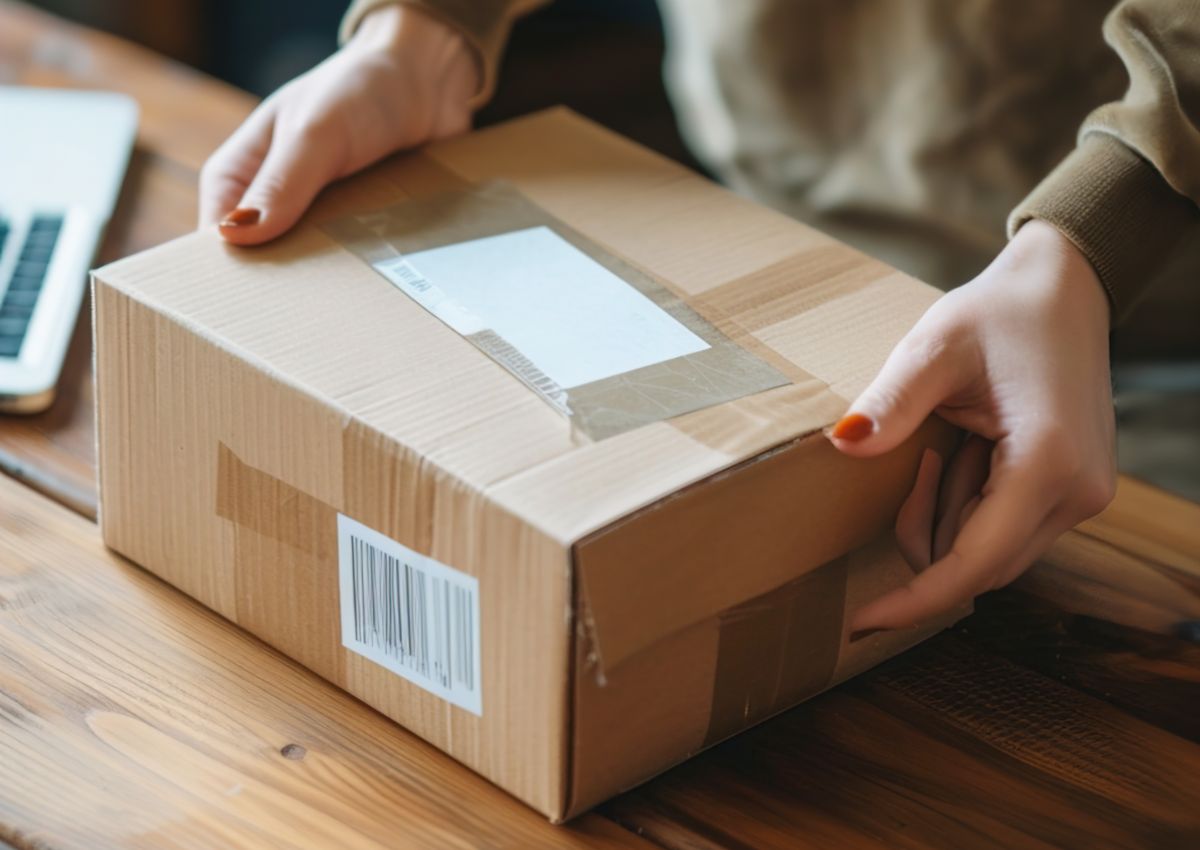Argos is rolling out its own fleet of vans to offer customers a same-day delivery service across the UK before the end of 2015. Emma Herrod spoke to Andy Brown, central operations director at Argos about the company’s motives and how Fast Track delivery will work.
At the eDelivery Conference, earlier this month, Andy Brown from Argos talked about the latest move in the retailer’s evolving delivery model – the nationwide roll out of Fast Track, which started life as a trial in the south east of England.
Under Fast Track, items ordered by 1pm will be delivered between 2pm – 6pm, orders placed by 6pm will be delivered between 7pm – 10pm and those placed before midnight will be delivered the next morning between 7am and 10am or 10am and 1pm. Customers can pick exactly when they want their delivery made, choosing one of the four daily delivery slots that are available seven days a week, bank holidays included, up to 21 days in advance. Initially, it offered three delivery slots – morning, afternoon or evening – but the first has now been split to give a time outside of the morning school run.
Andy Brown, central operations director at Argos Stores, describes it as similar to how shoppers choose a delivery slot for online groceries. “With general merchandise, customers want their goods as soon as possible,” he says. The early slots are the most popular. Otherwise, customers choose Sunday evening or other times at the weekend to fit in with their lifestyle.
What makes the service stand out, though, is that this is not a premium service: it’s the new standard delivery from Argos that it will operate itself, making the deliveries using its own vans and staff rather than courier services. It’s on track to roll the service out nationally before the end of 2015.
 “We now have a whole set of options to offer customers,” says Brown, explaining how the Fast Track delivery service will enable orders to be shipped from one of 160 hub stores for just £3.95 – the price of its existing standard next-day service, which fulfils orders from a DC.
“We now have a whole set of options to offer customers,” says Brown, explaining how the Fast Track delivery service will enable orders to be shipped from one of 160 hub stores for just £3.95 – the price of its existing standard next-day service, which fulfils orders from a DC.
Why has the retailer decided to do its own deliveries rather than working with a courier? Indeed, what does this mean for the 90-minute delivery option it already offers customers from 312 stores using the Shutl courier service?
Brown explains that Argos wants to offer customers product when they want it, how they want it, at a good price and through the channels they want to use. “This is a core part of who and what we are, so of course we want to own it and build it ourselves,” he says.
Shoppers in the south east, particularly in London, are used to swift or one-hour delivery times, but the hub and spoke logistics model operated by Argos is allowing the retailer to offer this type of service nationwide – and that’s the game changer.
Brown adds that the service is already making customers see Argos in a new light; they can see the transformation that it’s undergoing and it’s making them rethink their opinion of the retailer. It will retain the Shutl service for customers wanting an even swifter delivery option.
OPERATIONS
So, how does Argos operate its same-day delivery service? For many years, it has operated on a single-line, single-item basis with cartons split at its DCs and individual items delivered to stores, Brown explains. The items are stored in the warehouse area at the back of shops wherever there is space on shelves on each floor; fast-selling items are put closest to the selling area. A voice-operated warehouse management system is used to put goods away and for picking, with store staff quoting the catalogue number, aisle and shelf number into a headset as they store items.
Argos now has consolidated into a single view of stock across warehouses and stores so staff and customers are able to see exactly what is in stock and where every item is. This information is served to the digital channels in real time so customers can check whether the store from which they want to pick up an order has the products in stock or whether they are available in others nearby. Once the customer reserves or pays for an item, it is then ringfenced and systems updated.
The hub store I visited in Camden has three floors of warehousing hidden behind the customer-facing digital store. At these digital stores (of which there are now 140 – including the 80 concessions in Homebase, outlets at London Underground stations and 10 stores within Sainsbury’s – a figure which is set to reach 200 by the end of Argos’s financial year at the end of February 2016) items are reserved for each customer as they order them on a tablet in store. The items are picked immediately so they are ready for collection when the customer reaches the till. Argos outlets within Homebase stores are also being used as convenient pick-up locations as they carry some items which are common to both stores.
All this means that the company can maintain a 99.99% stock accuracy level, an achievement that has been at the heart of its Check & Reserve service for years.
It is also behind its Fast Track collection service, which now operates nationally, allowing customers who have already paid for items online to be in and out of a store in just 60 seconds. Items for Fast Track collection are placed on special shelves behind the tills ready for the customer to pick up.
There’s a similar procedure for eBay orders, which are delivered to store by recognised couriers and kept on dedicated eBay shelves. The retailer has been a pick-up point for customers ordering from eBay since pre-peak 2013, when the service was launched at 150 stores. It rolled out nationally in 2014 and the number of eBay sellers offering the service has now increased to 200,000. In operation, the correct label is printed by the seller from the eBay site with recognised couriers used to deliver the order to the requested Argos store. The orders are handled independently in store via a separate eBay terminal. To date, 2.5 million orders have been collected.

HUB & SPOKE
The Argos hub and spoke logistics operation sees larger stores act as mini distribution centres holding stock for a number of smaller outlets in the vicinity that don’t have the space to hold a full range. The hubs carry 80,000 – 90,000 items from 20,000 SKUs. The mix of stock held in each of these depends on the location of each store and the historic and forecast customer demand for items at the hub store and the corresponding spoke stores to which it delivers.
Generally, each hub holds stock for five local stores, each holding 10,000 – 12,000 SKUs, and a van travels between them in rotation moving stock out from the hub to its spokes. These same vans that are driving between hub and spoke stores are also being scheduled to make home deliveries to customers from store stock with the new Fast Track delivery service. According to Brown, the company moves a quarter of a million items between hubs and spokes each week.
This model means the retailer can give customers access to the 20,000 products held at its hub stores, quickly moving them to a spoke store for collection – and now delivering to their home. New, smaller-format stores have been introduced to take advantage of this system. These include Argos concessions within Sainsbury’s supermarkets and Homebase stores and Argos Collect stores at London Underground stations. The Canon Street store, for example, which opened in November 2014, is just 650 sq ft in total with a sales floor of 170 sq ft. Deliveries are made to it twice a day from its hub store.
When making a purchase for collection at a spoke store, customers can order by 1pm for collection from 4pm onwards or order after 1pm for collection the following day.
MOVING STOCK AT HUB STORES
Hub stores operate like a regular Argos store, serving walk-in customers and those who have reserved items online from stock in the warehouse. When an item is ordered from an iPad in the new-format digital stores, it is picked straight away before the customer even reaches the till. Items ordered online for Check & Reserve – which are paid for in store – are ringfenced for the customer until the end of the following day before being added back into the stock pile. Orders for Fast Track collection, which the customer pays for online, are picked and moved to shelving behind the tills, ready for them to collect from the Fast Track collection point. Argos aims to be able to serve these customers in under 60 seconds.
 The hubs also have to fulfil orders from their spoke stores, and these are batch picked once a cut-off time has been reached. Products that come in large boxes have a label applied to them while others are bagged and then labelled. They are then loaded onto a van for the delivery run. Overnight orders are picked, ready to arrive at the spoke store for the 9am opening time.
The hubs also have to fulfil orders from their spoke stores, and these are batch picked once a cut-off time has been reached. Products that come in large boxes have a label applied to them while others are bagged and then labelled. They are then loaded onto a van for the delivery run. Overnight orders are picked, ready to arrive at the spoke store for the 9am opening time.
Brown says that when the hub and spoke model was first implemented and customers had a view of stock held in the various stores, most hubs saw a decline in sales. He attributes this to the fact that customers were having items sent to a more convenient spoke store and collecting their order from there. There was also incremental sales growth at the spoke stores, which Brown thinks was down to the added convenience. These smaller outlets were able to pick up orders for items that customers might have bought from elsewhere in the past because they weren’t available at their local store.
The process for home delivery from store is similar. “We’re used to picking single items from store, so instead of the items going to another store they are being delivered to the customer’s home,” says Brown. These orders are bagged and/or labelled in the same way, consolidated and then loaded onto an Argos van.
Home Delivery software from Paragon links seamlessly with the retailer’s existing multichannel order processing system. This is updated in real time so at the point of order customers are offered only the home delivery or collection time slots that the company can fulfil.
The Paragon solution continually re-optimises the transport schedules as new orders are added. Taking into account delivery areas, available resources and existing deliveries already confirmed, the software analyses and evaluates possible delivery times for new orders. By planning customer collection and home delivery services using the same system, Argos can maximise the efficiency of its operation while offering a consistent, reliable service to customers.
“We only offer what we can deliver,” says Brown, so the customer knows exactly when their order will be delivered.
The final routing schedule for each van is made after the pick cut-off time, which means orders can be amalgamated right up to cut-off – and this includes cancellations, explains Brown. Customers can also return items fast. They can bring them back to a store, or if something has been delivered to them using the Fast Track delivery service, they can arrange a Fast Track return. Replacement orders are handled separately.
PEOPLE MAKE THE PROPOSITION
The new service also has a human aspect. Argos says it wants to “differentiate by service”, offering the same service at the customer’s door that‘s provided in-store. This is one of the reasons why it will be running its own delivery network and is currently recruiting Customer Fulfilment Assistants across the country. “We are looking for drivers with a difference – people who not only love being out and about in their community, but who are good communicators and passionate about providing great customer service, to ensure we can deliver a brilliant service that we are known for, store to door,” says the recruitment information.
These sentiments are echoed by Brown, who explains that the retailer is recruiting people with a personality suited to customer services rather than just the ability to drive a van. “Our very best drivers were working in store,” he adds.
 The recruitment drive also indicates the planned size of the network: during August, for example, the company was seeking 18 drivers for immediate start in the Chester area, 12 for its Meole Brace store in Shrewsbury and 16 on permanent contracts in Tunbridge Wells. Its extra staff to cover peak trading start on 1 September, though, so it’s unclear how many of these drivers will be working for the company post-Christmas. It is known that around half of Argos’ total sales now start online, but 90% of customers will visit one of its 755 stores to collect their order. That would have left an estimated £90m worth of orders to be delivered to customers in the past quarter, which saw sales reach £897m.
The recruitment drive also indicates the planned size of the network: during August, for example, the company was seeking 18 drivers for immediate start in the Chester area, 12 for its Meole Brace store in Shrewsbury and 16 on permanent contracts in Tunbridge Wells. Its extra staff to cover peak trading start on 1 September, though, so it’s unclear how many of these drivers will be working for the company post-Christmas. It is known that around half of Argos’ total sales now start online, but 90% of customers will visit one of its 755 stores to collect their order. That would have left an estimated £90m worth of orders to be delivered to customers in the past quarter, which saw sales reach £897m.
Now that hub and spoke is fully operational and Argos vans will be driving around the country, how will the service develop? There have been rumours that it plans to extend its warehousing and click-and-collect facilities to other retailers, and it’s known to be rolling out nationally the trial of a two-man, next-day home delivery service for larger items such as washing machines and furniture to customers direct from DCs.
The scale of its DCs-to-stores network is already well understood but, as many retailers have discovered recently, the cost of fulfilling click-and-collect orders is another matter – and the further movement of those orders in the final mile adds complexity and cost. Argos is well known for its ability to test and scale, so the full size of its fleet and the movement of stock both up and down the chain will be interesting to observe. Unfortunately, Brown would not reveal the firm’s other plans, except to say of national delivery that “we are always talking to other people.”
He says that the firm’s desire to offer customers product when they want it, how they want it, at a good price and through the channels they want to use is a “core part of who and what we are so of course we want to own [the fleet of delivery vans] and build it [the network] ourselves.”
ADDITIONAL INFORMATION:
Proposition and economics
Why is Argos delivering to customers itself rather than working with established carriers? One reason, Brown says, is that no one offers the service that Argos wants to provide: four delivery slots a day, seven days a week. Also, the economics of using a third party do not stack up. “Our last mile costs are higher,” he says. The retailer has already trunked the stock to the local vicinity very efficiently and is holding it in a larger number of hubs than the carriers operate. “The economics and the proposition are different to what a courier could do,” Brown explains. Also, Argos can control the quality of service on the customer doorstep by using its own staff.
Main Image:
Olympic sprinter Iwan Thomas launches the Argos Fast Track delivery service, at North Weald Airport in Essex. (David Parry/PA Wire)
[EDM03]










